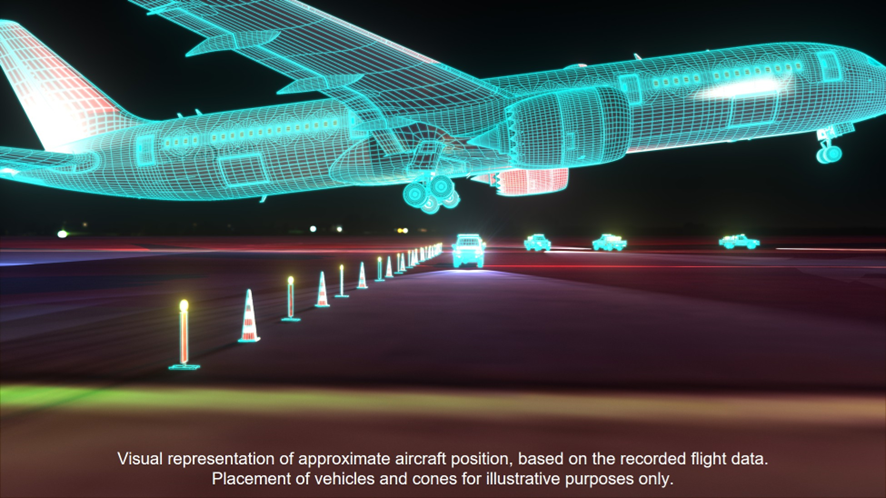Two international airliners, both with more than 200 people on board, overran a shortened runway and took off only metres above an active worksite at Melbourne Airport in September 2023, an ATSB investigation report details.
Prior to each incident the airport’s runway 34, normally 3,659 m in length, had been temporarily shortened by 1,568 m at night for a resurfacing project, leaving 2,089 m of runway available.
The first of these serious incidents occurred on the night of 7 September 2023, when a Malaysia Airlines Airbus A330-300 overran the available length while taking off for a flight to Kuala Lumpur, passing only 7 metres above work vehicles.
In response, Melbourne Airport conducted a risk review, and took additional safety action including updating existing communications and issuing a safety alert to airlines.
However, 11 days after the first incident, a Bamboo Airways Boeing 787-9 also overran the same temporary runway end, while taking off for a flight to Hanoi, this time passing less than 5 metres above the active worksite.
Both times jet blast impacted the works area where personnel and equipment were present. No workers were physically injured, but one stress-related injury resulted from the second incident.

To scale visual representation of the 787 taking off over the works limit.
The reduced runway length had been notified to flight crews through NOTAMs (notices to airmen) and broadcast over radio by the ATIS automatic terminal information service.
“Neither flight crew identified that the runway was significantly shortened, despite the relevant NOTAM being provided in their flight briefing packs,” ATSB Chief Commissioner Angus Mitchell said.
“And while both crews accessed a version of the ATIS that mentioned the shortened runway, they only noted to air traffic control the weather information from the ATIS, and not the reduced runway length.”
In addition, while each airline’s flight dispatcher had accounted for the reduced runway length in their indicative take-off performance calculations, they did not specifically highlight the shortened runway in the flight crews’ pre-flight briefing packages. This was likely since each aircraft was able to safely depart from the reduced length runway if appropriate power settings were applied.
“This oversight contributed to both flight crews using the full runway length in their pre-flight performance calculations, and subsequently conducting the take-offs with reduced thrust settings*.’
A full and correct understanding
It is a fundamental pilot responsibility to identify safety-critical aeronautical information when preparing for a flight, but that this process is susceptible to human error, Mr Mitchell noted.
“The risk controls to prevent these occurrences were predominantly procedural: relying on flight crews to carefully review aerodrome information, then identify and understand essential information – in this case, the reduced runway length available,” he said.
“Relying on predominantly procedural defences to recognise and comprehend hazards does not guarantee that flight crews will always have a full and correct understanding of operational conditions.”
Given the likelihood of missing or misunderstanding safety information, the report highlights the opportunities for additional risk controls to enhance pilot situational awareness.
“Considering the potentially catastrophic consequence of departing aircraft impacting an active works area, additional defensive layers aimed at alerting flight crews to significant runway hazards should be implemented,” Mr Mitchell said.
These can include enhancing communication of safety-critical information through flight dispatch, air traffic control, and highly conspicuous airport signage.
“In these incidents both airlines expected their dispatchers to highlight to their pilots all types of flight information critical for flight safety, but neither operator ensured this occurred,” Mr Mitchell said.
Both airlines have subsequently updated their flight dispatcher procedures and guidance.
In addition, the investigation notes Australian regulations only required air traffic control to confirm that flight crews had received the latest version of the ATIS – not that they had received the information in full. This was in line with International Civil Aviation Organization (ICAO) standards.
“Air traffic controllers have well defined and set responsibilities, which currently do not necessarily require them to directly advise flight crews of all safety critical information,” Mr Mitchell said.
“However, where there is doubt or potential that a significant safety hazard may not be understood or acknowledged, they can use their best judgement when it’s prudent to intervene.”
As a result of these incidents, Airservices Australia, in consultation with the Civil Aviation Safety Authority, has proposed changes to ATC procedures in providing essential aerodrome information associated with runway works that reduce available runway lengths.
Mr Mitchell said the ATSB would monitor the progress of this safety action and is recommending ICAO similarly review the Annex 11 standards and recommended practices for air traffic control.
“With the release of this investigation report the ATSB has issued a formal safety recommendation to ICAO that it review Annex 11 to include procedures for air traffic control communications to increase assurance that flight crews have received safety-critical aerodrome condition information,” Mr Mitchell said.
“Changes in response to this recommendation would improve aviation safety worldwide.”
Finally, Mr Mitchell also noted ICAO has adopted amendments to Annex 14 which covers aerodrome standards and recommended practices. The amendments introduce high conspicuity signage at airports to indicate temporary changes to runway declared distances.
The Civil Aviation Safety Authority has advised these changes will be reviewed for inclusion in relevant Australian regulations as part of the normal regulatory change process.
“Conspicuous visual aids, such as the signage proposed to be introduced to ICAO Annex 14, can assist as a final defence by providing an indication of changes to the runway conditions, where the runway would otherwise appear normal to flight crews,” Mr Mitchell concluded.
“Flight dispatchers, aircraft operators, airport operators, individual air traffic controllers, air traffic services providers and others can all contribute to ensuring pilots are aware of safety‑critical information when they need it.”
Read the final report: Runway excursions on take-off involving Airbus A330-323, 9M-MTL, and Boeing 787-9, VN-A819, Melbourne Airport, Victoria, on 7 and 18 September 2023
* Reduced thrust take-offs are a common practice when the aircraft’s operating weight and available runway length does not require maximum engine thrust be used on take-off. Reduced thrust take-offs increase engine life and reduce maintenance costs through reduced engine wear.


